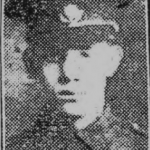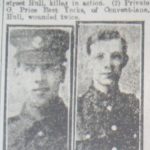BORN HULL 1899. SON OF WILLIAM JARVIS (1849-1926) & ELIZABETH VAREY (1868-1931), OF 16,BRIGHTON TERRACE, ADELAIDE STREET AND 15, DAY STREET, ANLABY ROAD, HULL (WAR PENSION ADDRESS). SON OF A FRUIT BROKER. HE HAD THREE BROTHERS AND TWO SISTERS. WORKED FOR BIELBY AND SONS, CARTING AGENTS, HULL.
HE ENLISTED IN HULL WHEN WAR BEGAN. SERVED WITH THE 1/4TH EAST YORKSHIRE REGIMENT. SAW SEVERE FIGHTING AT YPRES IN 1915. KILLED IN ACTION, AT THE SOMME, ON 15/09/1916, AGED 17. HE IS COMMEMORATED ON THE THEIPVAL MEMORIAL TO THE MISSING, FRANCE.
HE HAD SERVED IN THE ARMY FOR 7 YEARS AND 57 DAYS. HIS PHOTOGRAPH WAS PRINTED IN THE HULL DAILY MAIL ON THE 27TH MAY 1915. *
HIS NAME WAS RECORDED ON THE WAR MEMORIAL AT ST THOMAS CHURCH, CAMPBELL STREET, WHICH WAS DESTROYED IN AN AIR RAID DURING WW2.
HIS HALF BROTHER, SERGEANT, CHARLES WILLIAM VAREY, ALSO OF 15, DAY STREET, SERVED IN THE 1/4 TH EYR AND WAS KILLED IN ACTION ON 29/06/1915, AGED 23. HE IS COMMEMORATED ON THE YPRES MENIN GATE MEMORIAL, BELGIUM. HIS DEATH WAS REPORTED IN THE HULL DAILY MAIL ON THE 9TH AUGUST 1915.
ANOTHER BROTHER, ALBERT WALKER VAREY, WAS KILLED IN AN AIR RAID IN 1915, AGED 38.
“After training, 50th (Northumbrian) Division moved into the line on 9/10 September ready to participate in the Battle of Flers–Courcelette on 15 September; however, the 1/4th East Yorkshires lost 11 killed and 51 wounded to enemy shellfire between 9 and 13 September. During the night of 14/15 September the battalion moved into Swansea Trench. The artillery had been bombarding the enemy lines for three days; at Zero hour the guns would commence firing a Creeping barrage, which 150th Bde would follow. 1/4th East Yorkshires was the right-hand battalion of the brigade, tasked with seizing and holding the Starfish Line. The battalion formed up in four lines of three platoons from B, C and D Companies, while A Company provided carrying parties in the rear. The attack was preceded by two Mark I tanks, making their first appearance on the battlefield. The tanks, D24 and D25, crossed Swansea Trench at 06.03 and began making their forward through lanes left in the barrage. At 06.15 they crossed the rise over which the East Yorkshires were to attack, and at 06.20 (Zero) the battalion began its advance. D24 (‘Male’, equipped with two 6-pounder guns) straddled the first objective (Switch Trench) and subjected the defenders to enfilade fire, while D25 (‘Female’, with four Vickers machine guns) moved on to do the same at Hook Trench, causing the Germans to flee. 150th Brigade sent many frightened prisoners back to the British lines without escort. 1/4th East Yorkshires reached Switch trench without difficulty in 10 minutes, and B and D Companies advanced to Hook Trench. The tanks moved on again at Zero + 40 minutes (07.00). D24 was then hit by two shells, one of which disabled a track, so the crew disembarked with their Hotchkiss light machine guns and joined the infantry. D25 continued to a sunken road, and after another pause resumed its advance along the edge of Martinpuich, silencing German machine guns, before returning to refuel. However, 149th (Northumberland) Bde to the right had been less successful, and with its flank exposed 1/4th East Yorkshires had been unable to get beyond Martin Trench, reporting the Starfish Line to be full of German troops. Next morning 150th Bde made another attempt on the Starfish Line, with B and D Companies attacking, but with their flank still open they were pinned down between Martin and Starfish, and the whole brigade was shelled all day. 1/4th East Yorkshires were withdrawn during the night of 16/17 September. The battalion had losses of 32 killed, 205 wounded and 13 missing, leaving a front line strength of just 14 officers and 373 other ranks. Even when the companies rejoined the rest I Male tank, preparing to advance at Flers–Courcelette.of the battalion in the transport lines, it only amounted to 18 officers and 457 other ranks.”

